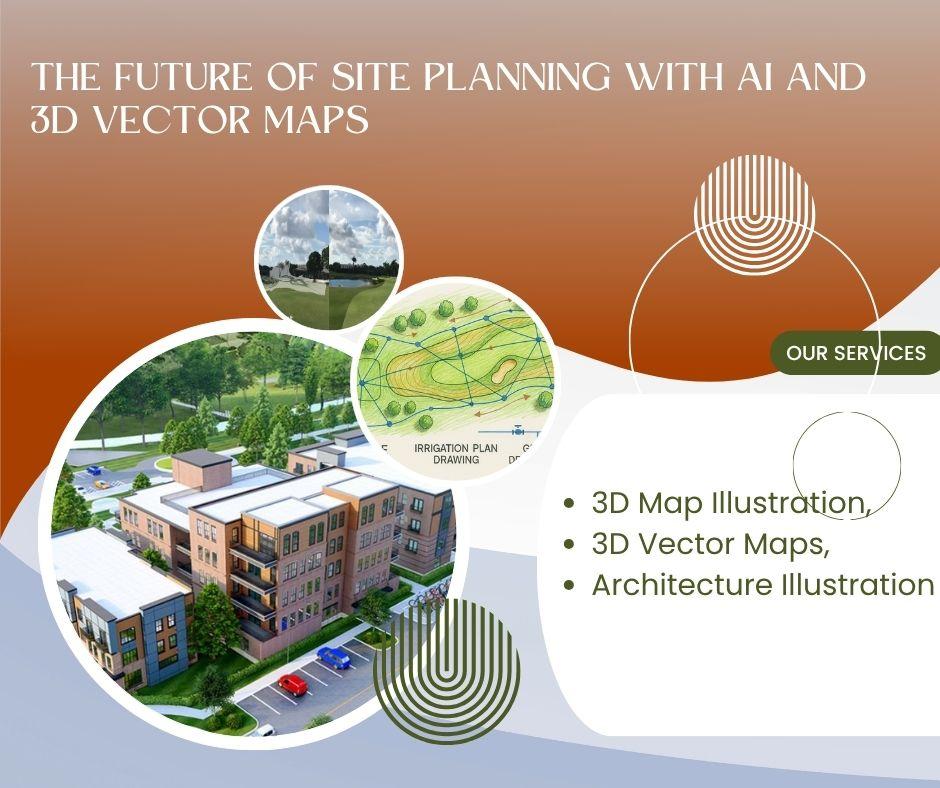Using 3D Map Illustration in Public Infrastructure Projects

How to Use 3D Map Illustration in Public Infrastructure Projects: Bridging Vision and Reality
Public infrastructure projects are the backbone of any thriving society, encompassing everything from new transportation networks and utilities to vital public spaces and civic buildings. These undertakings are inherently complex, involving multiple stakeholders, vast budgets, extensive planning, and significant public impact. Traditionally, communicating the scope, design, and benefits of such projects relied on technical drawings, static maps, and written reports – mediums often inaccessible or unengaging for the general public and even some non-technical decision-makers. However, the advent of 3D Map Illustration has revolutionized this process, transforming abstract plans into clear, compelling, and immersive visualizations.
By creating highly detailed, interactive, and visually rich representations of proposed infrastructure, 3D Map Illustration serves as a critical bridge between the technical vision and public understanding. Powered by precise 3D Vector Maps and enhanced by detailed Architecture Illustration of key structures, this technology is not just an aesthetic enhancement; it's an indispensable tool for public engagement, stakeholder alignment, and efficient project delivery in the realm of public infrastructure.
The Power of Perspective: How 3D Map Illustration Transforms Public Engagement
3D Map Illustration is more than just a pretty picture; it's a strategic communication asset that can significantly enhance public engagement and understanding.
-
Clarity and Comprehension: A well-crafted 3D Map Illustration immediately clarifies the project's spatial impact, showing how new roads, bridges, or parks integrate with the existing urban fabric.
-
Visualizing Benefits: Instead of merely stating that a new park will enhance green space, a 3D Map Illustration can vividly show families enjoying redesigned areas, cyclists on new paths, or improved views, allowing the public to emotionally connect with the benefits.
-
Addressing Concerns: For potentially contentious projects (e.g., new highways, waste treatment facilities), a 3D Map Illustration can clearly depict mitigation measures, such as noise barriers, green buffers, or enhanced pedestrian crossings, directly addressing community concerns.
-
Showcasing Phasing: For multi-year projects, a series of 3D Map Illustrations can depict different construction phases, managing expectations and demonstrating the long-term vision. This helps maintain public patience and understanding.
-
Accessibility for All: Modern 3D Map Illustration can be integrated into interactive websites, touch-screen kiosks, or even virtual reality experiences, making it accessible to a wider demographic and encouraging active exploration of the project.
The Data Backbone: Precise 3D Vector Maps
The stunning realism and analytical power of 3D Map Illustration in infrastructure projects are directly dependent on the underlying 3D Vector Maps.
-
Geospatial Accuracy: 3D Vector Maps are built upon highly accurate geospatial data (LiDAR, drone surveys, satellite imagery), ensuring that every contour, existing building, and proposed infrastructure element is precisely located in three dimensions.
-
Semantic Layering: Each feature (road, river, building, utility line) is a vector object with associated data attributes (e.g., road width, building height, material, land use zone). This semantic richness allows for complex queries and analysis within the 3D Vector Maps.
-
Dynamic Information: The vector nature of these maps means that information can be easily updated, analyzed, and manipulated. If a design change occurs in a bridge, the 3D Vector Maps can be quickly revised, and its impact on traffic flow or sunlight access can be re-simulated.
-
Integration of Engineering Data: Complex engineering data – bridge structural components, tunnel routes, utility pipe networks – can be directly integrated into the 3D Vector Maps, providing a unified data environment for all project disciplines.
-
Environmental Data Overlay: 3D Vector Maps can overlay environmental data such as flood plains, vegetation types, and wildlife corridors, allowing planners to visualize potential impacts and design mitigation strategies, crucial for sustainable public infrastructure.
Showcasing the Structure: Compelling Architecture Illustration
Within the broader context of a 3D Map Illustration for infrastructure, detailed Architecture Illustration plays a vital role in highlighting key structural and civic elements.
-
Iconic Structures: For projects involving new bridges, public buildings (e.g., libraries, transit hubs), or significant art installations, high-fidelity Architecture Illustration provides detailed views that showcase their design, materials, and aesthetic contribution to the urban fabric.
-
Human Scale and Detail: Architecture Illustration often includes human figures, landscaping, and street furniture to convey the scale of the proposed structures and how people will interact with them, making them feel more approachable and inviting.
-
Material and Finish Reality: The Architecture Illustration meticulously renders the intended materials (concrete, steel, glass, wood), ensuring they appear realistic under various lighting conditions, conveying the quality and durability of the public infrastructure.
-
Impact on Streetscape: Architecture Illustration helps visualize how new structures will affect the pedestrian experience, sightlines, and overall streetscape, crucial for urban integration.
-
Interior Accessibility: For public buildings, a select Architecture Illustration might even offer glimpses of key interior public spaces (e.g., a station concourse, a library atrium) to demonstrate functionality and design quality.
-
Nighttime Lighting: Architecture Illustration can show how structures will appear at night, with planned lighting schemes that enhance safety, aesthetics, and wayfinding, often crucial for attracting users to public spaces after dark.
The Workflow of AI, 3D Vector Maps, and Visualization
-
AI-Powered Analysis & Optimization: AI algorithms analyze the 3D Vector Maps for factors like optimal routing for transport, environmental impact, cost efficiency, and regulatory compliance.
-
Design Refinement: Architects and engineers refine the AI-generated proposals, iterating on the 3D Vector Maps to balance technical requirements with aesthetic and community needs.
-
Visual Storytelling: The refined 3D Vector Maps are then used to create compelling 3D Map Illustrations, including detailed Architecture Illustration of key structures, rendered as photorealistic stills, interactive panoramas, or dynamic animations.
-
Public & Stakeholder Engagement: These visualizations are deployed across various platforms for public consultations, government approvals, and investor presentations, fostering understanding and buy-in.
-
Digital Twin for Management: Post-approval, the 3D Vector Maps and models evolve into a comprehensive digital twin for construction management, facility operations, and future urban planning, ensuring the long-term success of the infrastructure.
Conclusion
In the complex and often contentious world of public infrastructure, effective communication is paramount to success. 3D Map Illustration, built upon precise 3D Vector Maps and enriched by detailed Architecture Illustration, has emerged as a revolutionary tool for bridging the gap between technical plans and public understanding. By transforming abstract concepts into clear, immersive, and highly engaging visualizations, 3D Map Illustration empowers citizens, aligns stakeholders, and streamlines the approval process. It allows communities to truly visualize how new roads will reduce commute times, how revitalized parks will enhance green spaces, or how a new transit hub will connect neighborhoods. The future of public infrastructure planning is inextricably linked to this powerful synergy, ensuring that our vital urban developments are not just functionally sound but also thoughtfully designed, widely understood, and passionately supported by the very public they serve.





